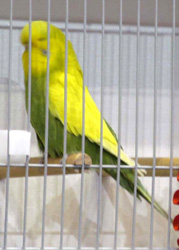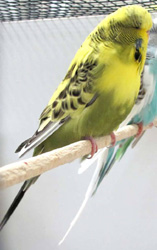
Too many exhibition budgerigars show color faults…
As an artist who has painted birds most of my life, it would have been a tragedy for me if I had been color blind. But, Sadly, some people seem to be willfully color blind, in ways I shall describe.
Fortunately. I can fully appreciate the qualities that bring birds to the forefront of natural history subjects. The wide range of colors found in the parrot family surely must rate among the most dazzling. Magnificent hues can be observed in aviculture from the rainbow lorikeet down to the diverse range of the popular budgerigar.
As a breeder and exhibitor of budgerigars, I have always loved the challenge of breeding new mutations and varieties of colors. The original light green wild budgerigar is a bird of outstanding beauty. The multicolor Spangle of today is another gem in nature. But let’s look at the problems as I see them.
Exhibiting budgerigars is a wonderful hobby, but the final adjudication sometimes leaves a lot to be desired, and the pet market also has to answer for a good deal.

Most qualified budgie judges handle their task with enthusiasm and deliver a first-class result, but there are grey areas that need to be tackled, especially in the rare and new variety sections. The main fault found in standard groups, such as normals, are the opalescent markings on the neck and saddle of the bird. The bird must have a body color of the variety, with black and white as a feather pattern in the blue series, and yellow and black in the green series.
With today’s many pairings, we find that the center of the shell-marked feather in the normal wing will be devoid of center grey color. An example is a black feather with a white or yellow edge. Genetically we cannot do anything but breed out this fault of color omission, and perseverance will finally find a result.
In the varieties of clearbodies, we should have a body of clear color – white or yellow – with a normal tail and wing, and spots. The flights are grey, a genetic facet of this variety. We see so much color creeping into the body these days – It’s a far cry from the original clearbody mutation.

Clearwings should have "clear wings".
Clearwings have always been a difficult variety for maintaining their visual patterns. We see so many dark-winged birds, along with pale cheek patches. The dark tail came from a decision to change from the light tail. That was a bad move. With the introduction of a melanistic color, we increase the dark pattern of the wings and back. So many suffused and pale birds are bred, which inevitably diminish the color strength in the bird.
Dominant pied is a variety that has been around for some time. The dominant pied of the violet form is a joy to behold, especially with a yellow face – what a superb contrast in a living bird.
The dominant pied has to have equal color patterns on the body and wings. But so many times we see full body color and, what’s more, nearly normal wing patterns that color the whole of the wing, except for the flights.


Some Recessive Pied hens have darker wing markings.
Recessive pieds again, fall into an incorrect color pattern that’s found in today’s exhibition budgerigars. The head must be clear of grizzle, flecking and so on, yet we still see birds that display these faults. The wngs also carry a heavy pattern, near to normal in some exhibits. We know that some hens are darker on the wings, but that is no excuse to let it happen in cock birds.
The recessive pied was once called the Harlequin, because it’s wing pattern resembles a harlequin dancer’s costume. Breeding this variety to increase its size has also brought into its genetic background a normal variety that seems to dominate its inheritance.

Visit Eric's website
to view his paitings and prints.
![]() Check
out more articles in our Reference
Library
Check
out more articles in our Reference
Library
